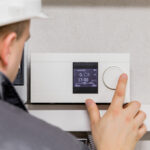When it comes to a number of HVAC areas within your home throughout the year, few elements are as important as the thermostat. Responsible for reading temperature and controlling air flow throughout the home, the thermostat plays a major role in everything from basic home comfort to energy efficiency and your HVAC costs each month.
At Action Plumbing, Heating, Air & Electric, thermostats receive plenty of attention during our standard HVAC maintenance and installation programs. From basic air conditioning tune-ups to full-on central air installation or related themes, we’ll keep the thermostat top-of-mind and ensure you’re familiar with all its settings and proper operation tips. In this two-part blog series, we’ll go over a variety of thermostat factors and recommended settings to keep your home not only comfortable, but also free of rising energy costs or other hassles.
Warmer Weather Temperatures
First and foremost, let’s go over some basic temperature settings to consider for your thermostat. We’ll start with the warmer periods of the year, such as the hot Utah summer we’re taking part in right now.
Generally speaking, we recommend homeowners set their thermostats between 76 and 78 degrees Fahrenheit during the summer depending on personal preference. This may vary somewhat if you have special temperature needs, such as a child or an infant who has a more specific temperature range.
Cooler Weather Temperatures
During fall and winter, on the other hand, the HVAC needs in your home will change from cooling to heating. During this period, the recommended thermostat setting is a bit lower, particularly while sleeping – you can get the thermostat as low as 70 degrees or even below this during these periods. Again, however, this may vary based on specific temperature needs from individuals in the home.
Considering Humidity
One other important factor here to consider is humidity, which refers to water vapor in the air that often makes it feel thicker and hotter. The outdoor temperature may be at a given point, for instance, but high humidity could add several degrees to how hot it feels just due to this water vapor.
Now, humidity is less of a concern in a place like Utah than many others, as it’s a very dry place without too much such water vapor. However, this can also mean your humidity level gets too low, risking dry air and uncomfortable living. If your humidity levels are outside the 30-50% range they should be in, speak to our team about how your thermostat plays a role here and how you might be able to utilize the AC to assist with humidity control.
For more on proper thermostat settings and related factors, or to learn about any of our plumbing or HVAC services, speak to the staff at Action Plumbing, Heating, Air & Electric today.


